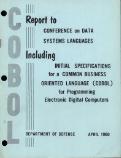COBOL
COBOL (/ˈkoʊbɒl, -bɔːl/; Common Business Ofented Language iborasidan qisqartirilgan; tarjimasi „umumqabul qilingan amaliy til“) — EHM yordamida iqtisodiy-hisob va boshqarish masalalarini yechish dasturini bayon qilishda qoʻllaniladigan dasturlash tili. Algoritmlarni EHMning qandayligiga bogʻliq boʻlmagan shakldagi yaqqol va ixcham qaydi olinishini taʼminlaydi. 1960-yillarda AQShda ishlab chiqilgan. Tilning inglizcha va ruscha variantlari mavjud; shakli matn koʻrinishda boʻladi. COBOL katta hajmdagi axborotlarni kiritish va chiqarish, razryadi oʻzgaruvchan sonlar ustida ishlash, chiqadigan axborotlarni murakkab hisobot shakli koʻrinishida tahlil qilish uchun ishlov beradi. COBOL algolta nisbatan amaliy operatsiyalarning odatdagi tiliga yaqin. COBOLda tuziladigan katta dasturlarni qisqartirish va ularni joylash uchun maxsus vosita bor[8].
 | |
| Paradigmalari | tartibotli, imperativ, obyektga yoʻnaltirilgan |
|---|---|
| Muallifi | Howard Bromberg, Norman Discount, Vernon Reeves, Jean E. Sammet, William Selden, Gertrude Tierney, Grace Hopper[1] |
| Tuzilgan yili | 1959 |
| Fayl kengaytmalari |
.cbl, .cob, .cpy |
| Dialektlari | |
| COBOL/2, DEC COBOL-10, DEC PDP-11 COBOL, DEC PDP-11 COBOL-85, DEC VAX COBOL, DOSVS COBOL, Envyr ICOBOL, Fujitsu COBOL, Hitachi COBOL2002, HP3000 COBOL/II, IBM COBOL SAA, IBM COBOL/400, IBM COBOL/II, IBM Enterprise COBOL, IBM ILE COBOL, IBM OS/VS COBOL, ICL COBOL (VME), Micro Focus ACUCOBOL-GT, Micro Focus COBOL-IT, Micro Focus RM/COBOL, Micro Focus Visual COBOL, Microsoft COBOL, Raincode COBOL, Realia COBOL, Ryan McFarland RM/COBOL, Ryan McFarland RM/COBOL-85, Tandem (NonStop) COBOL, Tandem (NonStop) SCOBOL, UNIVAC COBOL, Unisys MCP COBOL74, Unisys MCP COBOL85, Unix COBOL X/Open, Veryant isCOBOL, Wang VS COBOL | |
| Bunga asos boʻlgan tillar | |
|
AIMACO, COMTRAN, FACT, FLOW-MATIC COBOL 2002:[2][3] C++, Eiffel, Smalltalk | |
| Buning asosida tuzilgan tillar | |
| CobolScript,[4] EGL,[5] PL/I,[6] PL/B[7] | |
Manbalar tahrir
- ↑ Sammet, Jean E. (March 2000). "The real creators of Cobol". IEEE Software 17 (2): 30–32. doi:10.1109/52.841602. ISSN 1937-4194. "The Short-Range Committee worked diligently from June 1959 on, but there were great difficulties in having a fairly large committee try to create a programming language. In November, the Short-Range Committee chair appointed six people to develop specifications for consideration: William Selden and Gertrude Tierney (IBM), Howard Bromberg and Norman Discount (RCA), and Vernon Reeves and Jean E. Sammet (Sylvania Electric Products). We worked for two full weeks (including some round-the-clock sessions) in November 1959 and sent the proposed specifications to the full Short-Range Committee, which accepted almost all of them. After some editing (by the same six people), we turned in the specifications as a final report in December to the Executive Committee, which accepted them in January 1960. After some further editing, the Government Printing Office issued Cobol 60. […] [Grace Hopper] did not participate in its work except through the general guidance she gave to her staff who were direct committee members. Thus, while her indirect influence was very important, regrettably the frequent repeated statements that "Grace Hopper developed Cobol" or "Grace Hopper was a codeveloper of Cobol" or "Grace Hopper is the mother of Cobol" are just not correct."
- ↑ Arranga, Edmund C.; Coyle, Frank P.. Object-Oriented COBOL. Cambridge University Press, February 1998 — 15 bet. ISBN 978-0-13-261140-4. „Object-Oriented COBOL's style reflects the influence of Smalltalk and C++.“
- ↑ Arranga, Edmund C.; Coyle, Frank P. (March 1997). "Cobol: Perception and Reality". Computer 30 (3): 127. doi:10.1109/2.573683. ISSN 0018-9162.
- ↑ Imajo, Tetsuji et al. (September 2000). "COBOL Script: a business-oriented scripting language". Enterprise Distributed Object Computing Conference. Makuhari, Japan: IEEE. doi:10.1109/EDOC.2000.882363. ISBN 0-7695-0865-0.
- ↑ Ho, Wing Hong „Introduction to EGL“. IBM Software Group (2007-yil 7-may). 2019-yil 13-yanvarda asl nusxadan arxivlangan. Qaraldi: 2019-yil 12-yanvar.
- ↑ Radin, George (1978). "The early history and characteristics of PL/I". in Wexelblat, Richard L.. History of Programming Languages. Academic Press. 1981. p. 572. doi:10.1145/800025.1198410. ISBN 0-12-745040-8.
- ↑ „What is PL/B – The Programming Language for Business?“. sysmaker.com. Infopro, Inc.. — „"... conversion to an alternate, extended COBOL or to ANSI COBOL is very difficult, if at all possible"“. Qaraldi: 2022-yil 22-aprel.
- ↑ OʻzME. Birinchi jild. Toshkent, 2000-yil
Havolalar tahrir
- COBOL Curlie katalogida
Bu andozani aniqrogʻiga almashtirish kerak. |
| Ushbu maqolada Oʻzbekiston milliy ensiklopediyasi (2000-2005) maʼlumotlaridan foydalanilgan. |